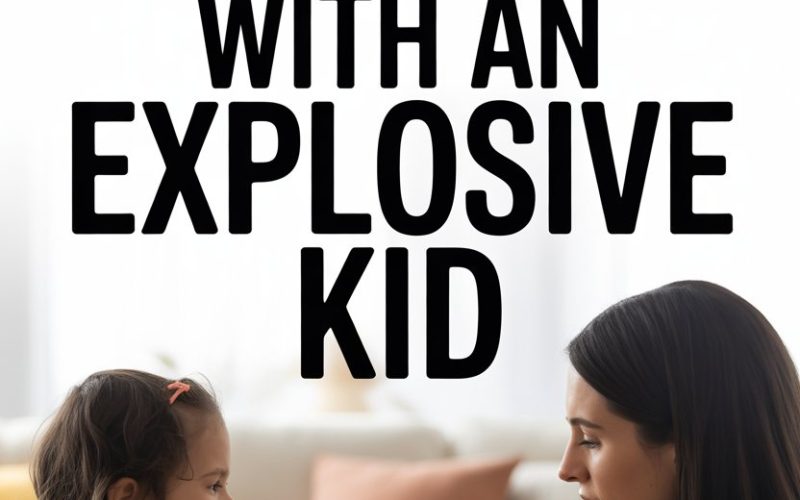Some children come into this world with a temperament set to “volcano.”
All is peaceful—until someone gives them the wrong colour cup. Suddenly, the living room doubles as a lava field, and you’re just trying not to get burned.
If you’re parenting a child with a “hair-trigger” (or living with one who thinks the dog stole their socks for the third time this week), you know these eruptions aren’t just loud—they’re exhausting.
Staying calm yourself is half the battle, and sometimes, it feels like the trickiest half.
Why Some Kids Blow Their Tops
Temperamental outbursts aren’t a sign of failure on your part, nor are they a sign that your little darling is destined to star in a documentary titled “Anger: The Early Years.”
Some kids are simply more reactive. Their nervous systems fire off with extra gusto, and self-regulation is a skill still under construction.
According to research from the Child Mind Institute, some children genuinely struggle to manage big feelings because their brains are wired to feel things more intensely.
And yes, stress, lack of sleep, hunger, or even itchy socks can tip the scales.
It’s Not Personal (Even When It Feels Like It Is)
Your explosive child isn’t actually plotting to ruin movie night. Children’s outbursts are rarely about you, even when they’re screaming your full name at a pitch that could shatter glassware.
They’re simply overwhelmed, and you’re the safest target. Clinical psychologist Ross Greene, author of The Explosive Child, frames these meltdowns as lagging skills rather than deliberate misbehaviour.
Kids “do well if they can,” he says—which means staying calm is all about helping them manage their feelings, not taking it on the chin.
How Parents React: The Real Game-Changer
Your response to your child’s meltdowns shapes how quickly things spiral—or settle.
Research from Harvard’s Center on the Developing Child highlights that when parents can stay emotionally regulated, kids are more likely to return to baseline.
But calm doesn’t mean robotic.
You don’t need to channel your inner Zen monk while dodge-rolling crayons. Instead, it’s about keeping your own temperature down, even when the room’s heating up.
Classic Calming Techniques—With a Parenting Twist
Deep breaths, anyone? The old chestnut works, but parents sometimes need tactics with a bit more “real world” staying power.
- Name what you’re feeling. Silently, in your own head: “I’m furious. I’d like to scream into a pillow.” Acknowledging your own frustration helps you respond thoughtfully, not reactively.
- Drop your shoulders and unclench your jaw. Your body will get the hint, even if your brain’s still imagining moving to a remote cabin.
- Use a mantra. “He’s not giving me a hard time, he’s having a hard time.” Cheesy? Maybe. Effective? Absolutely.
Be a Calm Mirror, Not a Sponge
Children borrow your emotional temperature. Think of yourself as a mirror, not a sponge. Absorbing your child’s anger or sadness only floods you both.
Reflecting calm shows them another way forward.
If your child’s shouting, resist the urge to shout back (even if your inner toddler is itching for a turn). Lowering your voice, speaking slowly, and keeping your face neutral can short-circuit a meltdown.
You’re not minimizing their feelings—just providing a soft landing.
The Power of the Pause
Reacting instantly is rarely helpful, unless you’re saving someone from stepping on a LEGO. During an outburst, give yourself full permission to pause. “Let me think about what to do next,” is a perfectly reasonable thing to say.
It buys you time to calm yourself and models slowing down for your child. Even pausing for a sip of water or a quick trip to the bathroom can help.
If you’re not sure what to do, say so. Sometimes, “I’m not sure how to help right now, but I want to help,” is the most honest—and de-escalating—response you can offer.
Rethink Timeout: Time Away, Together
Classic timeouts can feel punitive for kids with explosive tempers. Instead, time “away” can be a reset for both of you.
Some parents find that sitting quietly nearby, or offering to take a break together (“Let’s read a book on the sofa until we feel a bit better”) works wonders.
This “time in” approach is supported by psychologists who note that connection—not isolation—is more likely to calm the storm.
Look for Early Warning Signals
Kids rarely go from zero to Mount Vesuvius in one second flat. There’s usually a rumble before the eruption: clenched fists, a stomp, or a face that says “I’m about to blow.”
With practice, you can spot these signals and intervene early.
Sometimes, a quick snack, a silly distraction, or a change of scene (even just moving to a different room) can head off a blow-up. Don’t worry if you miss these cues now and then—nobody has the reflexes of a ninja, not even you.
What to Say When Emotions Run High
When your child is in meltdown mode, reasoning doesn’t work. (Asking them to “use your words” when they’re mid-wail is a bit like telling a tornado to take a tea break.) Instead, try phrases that show you see and accept their feelings:
- “You’re really upset right now.”
- “That must feel really hard.”
- “I’m here. I’ll help you when you’re ready.”
You’re not fixing the problem in this moment; you’re simply anchoring your child to reality.
Your Triggers Matter, Too
Every parent has their “button pushers.” If your child’s tantrums bring up feelings from your own childhood, or if you’re worn thin from work stress, your reactions will be bigger.
Recognizing this isn’t self-indulgent—it’s practical.
If you keep finding yourself losing your cool, give yourself a breather (even if it means parking your child in front of Bluey for ten minutes while you regroup). No medals are awarded for powering through at any cost.
When an Outburst Is Over
After the shouting stops and the tears dry up, the urge to lecture is strong. Try to resist. Kids are most receptive to learning after the storm has passed and everyone’s settled.
Briefly reflect together: “That was tough. What could we try next time we feel that way?” Keep it short and sweet, then move on. Dwelling isn’t helpful, for you or your child.
Prevention Beats Repair
Calm is easier to maintain when everyone’s needs are met. Well-fed, well-rested children (and parents) are far less likely to explode.
Routines help, too: knowing what’s coming next can settle an anxious system. Some families swear by visual schedules or checklists, which can give kids a sense of control.
Regular “connection time”—even just 10 minutes of undistracted play, pillow-fighting, or chatting about the day—can act as emotional glue, making your relationship more resilient when tempers flare.
Don’t Go It Alone
Parenting an explosive child is tough. If meltdowns are daily, affecting school, friendships, or your family’s wellbeing, reaching out for help can make a world of difference.
Behavioural therapists, parent coaches, and support groups can offer tailored strategies—sometimes just having someone listen is enough.
The National Parenting Helpline (US) or Parentline (UK) can point you in the right direction. You don’t need to fix everything solo.
A Note on Safety
Rarely, some children’s outbursts involve aggression or self-harm.
If you’re ever worried about your child’s safety, or your own, it’s time to loop in a paediatrician or mental health professional. Safety comes before any clever parenting technique.
Self-Compassion: The Secret Weapon
Here’s the bit most parenting books whisper about, but rarely shout from the rooftops: you’re allowed to be human. Losing your temper sometimes is part of parenting. Apologise, repair, and try again tomorrow.
Perfection isn’t required—consistency and connection matter much more.
Try treating yourself with the same kindness you offer your child after a meltdown. (Chocolate helps. So does calling a mate to vent.)
Small Wins, Big Progress
Every time you manage to stay calm during a blow-up, you’re teaching your child—loudly and clearly—how to handle hard feelings. Nobody gets it right every time.
You’re building skills, both for your child and yourself, one eruption at a time.
On the days when you keep your cool? That’s a genuine parenting win, and it’s worth celebrating.
Go on, put your feet up for a minute. It’s probably safe (until someone realises their sock is still missing).





